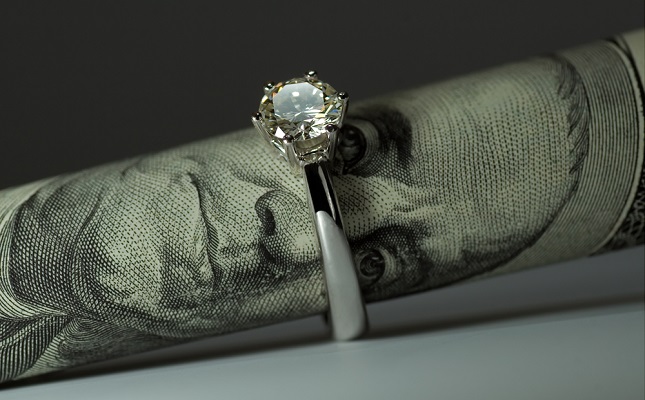AWDC And Bain & Co Report: Rough Diamond Firms to Boost Marketing Spend
December 12, 17
(IDEX Online) – Bain & Company’s seventh annual Global Diamond Report finds rough diamond players are likely to increase their marketing spend by about 50 percent over previous years to promote the diamond story.
Diamond producers staged a strong comeback in 2016 with demand for rough diamonds spurring a 20 percent increase in revenues as mining companies sold down inventories accumulated in 2015, the report says. However, the picture further up the value chain is less optimistic, due to waning consumer interest in diamond jewelry and intense competition from other luxury segments. In response, rough diamond producers are investing significantly to promote diamond sales. Additionally, the industry is renewing its approach to marketing to address evolving demand. This is according to Bain & Company’s seventh annual Global Diamond Report, developed in partnership with the Antwerp World Diamond Centre (AWDC).
Industry performance in 2016
Global sales of diamond jewelry were roughly stable last year. The U.S. remained the largest global diamond jewelry market, but sales were flat in 2016 following several years of consistent growth. China’s performance faltered, as the yuan posted its largest decline in value in 10 years and consumer confidence softened. A strike by jewelers and then demonetization disrupted India’s market. Meanwhile, Europe continued to struggle as tourist inflows plunged. Sales in Japan were a bright spot, showing growth in U.S. dollar terms.
Overall, the slowdown in global diamond jewelry demand and the resulting downward trajectory of polished diamond prices translated to a slight revenue drop in the cutting and polishing segment (midstream) in 2016. However, midstream players’ profitability improved in 2016, supported by declining rough diamond prices.
“The midstream segment’s future health will depend on the interplay of rough and polished prices as well as the segment’s ability to make continued operational improvements,” said Olya Linde, a Bain partner and one of the authors of the diamond report. “On that front, midstream players are maintaining intensive operational improvement drives, focusing mainly on reducing days to market, shortening cutting and polishing cycles, and securing financing. They are also implementing new technologies, such as automated cutting processes and advanced digital mapping and modeling of diamond cutting, to optimize yields.”
Global rough diamond production volume remained relatively flat in 2016 at 127 million carats, extending the trend of the last eight years.
High stakes for the global diamond industry
Long fueled by one of the most successful marketing campaigns of all time, the diamond industry enjoyed consistent growth through most of the 20th century. Yet, by the 2000s, generic marketing spending by rough diamond producers decreased from 5 percent to less than 1 percent of total sales of rough diamonds. Additionally, promotional efforts shifted to private brands. As a result, the growth of the rough diamond industry has trailed that of most other luxury products since 2000.
Compounding this challenge, consumers’ purchasing habits are changing, particularly among Millennials, who prefer ‘experiential’ luxury to tangible goods, such as apparel, accessories and jewelry.
In an effort to reverse these trends, rough diamond players plan to invest about $150 million in both generic and private brand marketing in 2017. Bain’s research suggests that sum is a 50 percent increase over previous years. The industry is also renewing its approach to marketing taking into account evolving customer preferences and marketing channels.
“Increasing demand for diamonds is a high stakes game for the entire diamond value chain,” said Linde. “Retailers are of course focused on making diamonds more attractive for consumers, but that’s only part of the story. Continued softening demand could have significant economic implications for entire nations that depend on the industry as one of their sole sources of revenue.”
The outlook for 2017 and beyond
The outlook for 2017 is stable across the diamond value chain. Rough diamond suppliers posted a 3 percent revenue decline in the first half of 2017, as lower priced assortments made up an increased share of their sales. Bain expects that the cutting and polishing segment’s revenue will stay flat in 2017. The revenues of major retail chains in key markets are trending up amid healthy macroeconomic fundamentals. Retail demand in India turned upward in 2017, after demonetization of large-denomination currency notes at the end of 2016 supported strengthening of organized jewelry retail.
Bain’s projections over the longer-term are upbeat, supported by positive economic and demographic indicators. However, future growth rests on two key assumptions: continued demand for diamond jewelry and a limited substitution of natural diamonds by lab-grown stones.
Ari Epstein, CEO of AWDC, said: “AWDC is pleased to present our seventh annual report on the global diamond industry, prepared in collaboration with Bain & Co. AWDC initiates these reports because we believe an informed diamond community is a prepared diamond community, and the challenges we face in Antwerp are intertwined with these the industry faces globally, now and in the future. We view these reports as a small part of our commitment to play a leading role in safeguarding the health of the diamond industry as a whole, which starts with a clear understanding of where we stand and where we need to go. Our local initiatives, whether they entail developing strategies to reinforce compliance and confidence in financial transactions, democratizing the supply of rough diamonds through a robust system of tenders, or steadfast efforts to increase consumer demand, are embedded in the objective of achieving a sustainable, ethical and thereby profitable diamond industry. This report is just one way we endeavor to realize that objective.”